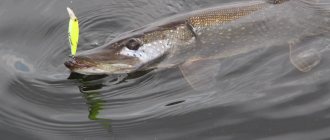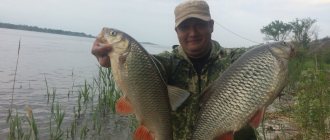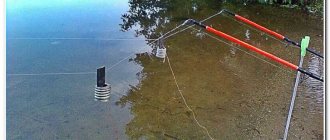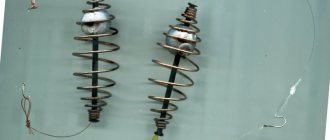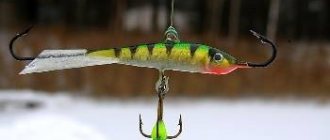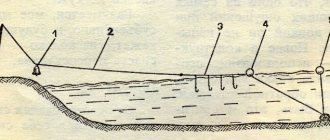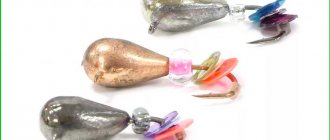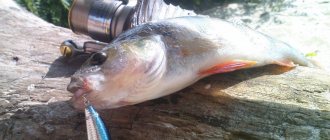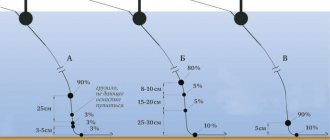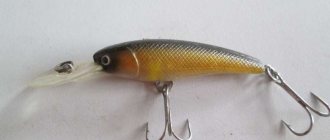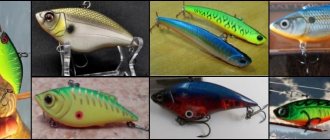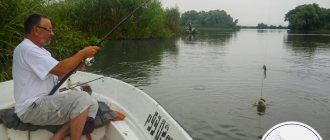Twitching - what is it?
Twitching is a technique of fishing with wobblers, in which a special jerking movement of the wobbler is carried out, simulating the movement of fish. Jerks are made with the end of the rod with varying strength and amplitude.
Twitching is actively used when catching predators: perch, pike, pike perch, asp, etc. This wiring is especially effective in situations when the fish is full and can only be forced to take the bait by the impudent, annoying behavior of this bait.
Wobblers for twitching
This type of bait has the greatest variety. There are all kinds of wobblers on store shelves: large and small, bright and not very bright, oblong and round, with one tee and two, from well-known manufacturers and cheap Chinese products. But not all of them are suitable for twitching.
Most often, the technique in question uses minnow baits; less often, anglers use shads.
The choice in this case depends on the fishing conditions and the behavior of the predator in a particular period.
Twitching wobblers may differ in buoyancy. Based on their buoyancy qualities, they are divided into the following types:
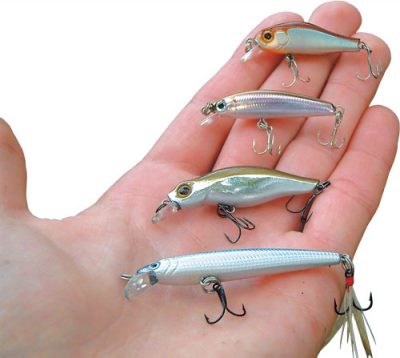
Floating. Such models are used in overgrown shallow water and clogged areas of the reservoir. They have a unique and very useful property: when encountering an obstacle, it is enough to stop the bait so that it floats up and goes around it from above. Good for fishing using the so-called “splash” method, with a pause after casting and subsequent sharp jerks.- Universal. Their depth is set by the manufacturer, and they hang there after casting. During movement, they can dive deeper or, conversely, rush to the surface. This variety is effective in places with weak currents.
- Drowning. Massive wobblers used in fast currents and great depths. They can have their own game.
Twitching tackle
The success of twitch fishing largely depends on the optimal choice of gear.
In this case, the fisherman must rely on such features of twitching as:
- Aggressive wiring.
- Wiring depth.
- Current speed.
- The nature and weight of the bait.
Rod
What kind of rod should be if you are going to fish with twitching?
First of all – easy. The twitching fishing technique assumes that the fisherman’s hand is constantly under tension, as he constantly has to perform jerking movements with the rod. A spinning rod with minimal weight will help relieve this stress and allow the fisherman to get satisfaction from fishing.
If we talk about the length of the rod, then the optimal solution would be to choose gear with a length of 1.8-2.4 m. Such parameters will allow you to feel the spinning rod as an extension of your hand and easily make any retrieve, changing the speed, intensity of twitching and frequency of jerks.
The aggressiveness of the wiring largely depends on the rigidity of the rod. A fast action rod will help you set a high speed for the bait when feeding. A medium action will not provide the desired aggressive start, so a spinning rod with a medium-fast action can be considered ideal.
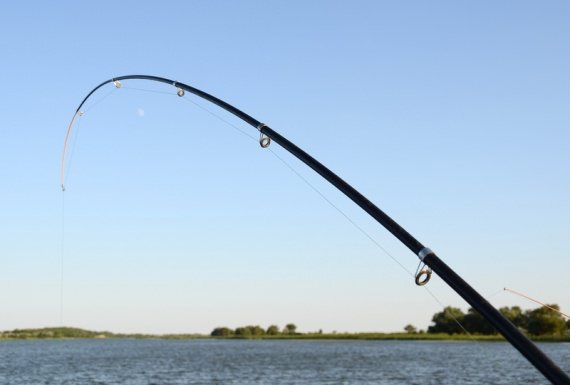
Coil
When fishing with twitching, you take both a spinning reel and a multiplier.
If you choose a spinning reel, make sure that it is not massive. The overall balance of the reel and rod is also important. After performing the next cast with such a reel, the spinning fisherman must reel in the slack fishing line, preventing the cord from coming off the reel and causing “beards” to form.
But still, it’s better to spend a little and buy a cartoon for twitching. This includes durability, casting range, and tighter winding of the fishing line, which guarantees its smooth descent.

fishing line
Give preference to thin braid with a gap of no more than 10 kilograms. A large diameter fishing line can interfere with the wobbler's play, so a fishing line with a diameter of 0.12 mm would be the best option.
But if you have more ambitious plans and you came to hunt for giant pikes, then try experimenting with braided line with a cross-section of 0.14 mm. Reel in the line in a timely manner, do not allow it to spontaneously drop from the spool, and experience the real excitement of hunting a toothy predator.
The leash for this type of fishing must be rigid, otherwise jerks during such fishing will contribute to its rapid wear. It is better to make a leash from wire or string. Its length should be no less than the length of the bait.
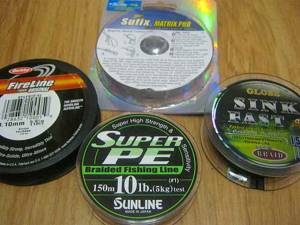
Volga: autumn twitching
- home
- Archive
- Nizhny Novgorod fisherman
- Volga: autumn twitching
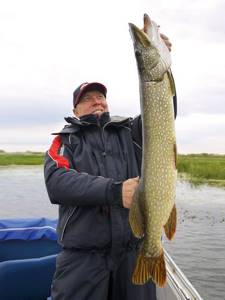
Valery Novosadov
When I come home after fishing, I always write down in my fishing diary where, what and what kind of fish I caught, sometimes I note the water temperature, the value of atmospheric pressure, and less often - the phase of the moon and the direction of the wind. By doing such simple things day after day, every month and for several years in a row, I have accumulated certain statistics, on the basis of which today we will try to build a conversation about autumn twitching and its features.
We will divide the baits used into groups and fishing methods. The first group includes wobblers with a large nose blade, which go deeper than two meters - this fishing method is usually called “deep-sea twitching”. The wobblers that I use most often for this type of fishing are POINTER 100DD and STAYSEE 90 ver.2 from LUCKY CRAFT; LIVEX REVENGE and LIVEX LEVIATHAN from MEGABASS; KILLER BILL and DIVING RIPRIZER from IMAKATSU. I spoke in detail about this method of fishing in the first issue of Nizhny Novgorod Fisherman for 2010.
The second group is large, up to 130 mm, wobblers Asura Rudra 130sp from OSP, Balisong 130 SP from DEPS, Mag Squad 128 from JACKALL BROS and Pointer 128 from LUCKY CRAFT. Let’s call the method of fishing with these baits “classic twitching.”
Let's also talk about jerk fishing, since the best time for fishing with this method is, of course, autumn. My jerking kit has not changed this year, but for twitching I have a new spinning rod from Norstream, the Kando 742M series, with a test of 728 and a length of 2.23. The tool, it seemed to me, turned out to be quite successful specifically for fishing with the above-mentioned baits. On occasion, it is quite possible to fish with a jig, but it is especially suitable for wobblers. The reel remains unchanged - Daiwa Certate Hyper Custom 2500.
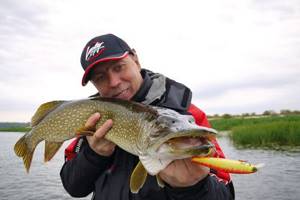
September
Fishing along the grass gives good results at this time. The vegetation has not yet fallen to the bottom this month; the fry, taking advantage of this circumstance, feels relatively safe here. Therefore, the pike is somewhere nearby. Most often we fish here with “classic twitching”, provided there is sufficient depth in the fishing area. But fishing is fraught with certain difficulties. We need to put the bait and move it as close to the grass as possible, sometimes touching the vegetation with the bait, but not catching it with the hooks. At this moment, our chances of getting a bite increase significantly. And, conversely, the farther we place our bait and move it from the edge of the vegetation, the less often we get bites. Let me emphasize: wiring must be done clearly along the grass, but not perpendicular to the line of aquatic vegetation.
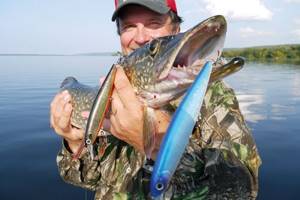
The next place where we can successfully catch pike is in extensive irrigation with depths of 35 meters and the presence of snags at the bottom. The use of classic twitching in such places is more justified than deep-sea twitching, precisely because of the snags. Despite the fact that wobblers from group 2 cannot be driven deeper than two meters, pike, even standing much lower, willingly rises to them. This happens due to the high activity of pike at this time of year.
Periods of pike activity during the day are usually called “outputs.” So, there are more and more predator outings in September, and they last longer than in August or November. The activity of the predator at this time is pleasantly surprising.
Let me give you one example. My magazine colleague Vadim Syromyatnikov and I were fishing in the Vasilsursk area in early September 2009 on one extensive watering hole with a depth of 35 meters. We caught it with Balisong130 wobblers from DEPS (don’t take it as an advertisement, but the wobbler is really very good).
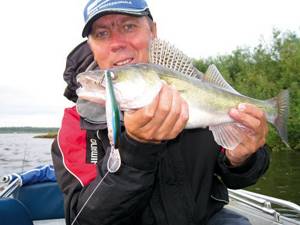
So, my partner, after biting and playing for a short time, had his wobbler cut off by a pike. The bait had a black back, brown sides and a red-orange belly. We always worry when we lose our favorite catchy bait. Vadim was also upset, and since there was no wobbler of the same color in his box, he had to put in a silver-blue Balisong.
On the next cast there was a bite again, and what a surprise we were when, having brought the pike to the boat, we saw two wobblers with it! The first one, which she cut off a couple of minutes ago, caught on her back with the rear tee (apparently the pike missed during the attack), as a result of which the cut occurred. But the second wobbler was in her mouth. Thus, we managed to catch a cunning pike and return the lost wobbler. After a short photo session, we gratefully released her.

But it is not always possible to detect and catch a predator even with an active search in an irrigation area or along the grass. In this case, there is also, as it seems to me, a win-win option - to look for pike on channel edges or in local holes (preferably with a current). Accordingly, switching to deep-sea twitching fishing. This type of fishing in September can easily compete with classic twitching and even jig. Moreover, it is not at all uncommon to catch large perch and pike perch in this way, in addition to pike. Weather observations show that pike readily responded to bait both in cloudy weather (sometimes with light drizzle) and in clear sunny weather, during times of high pressure.
October
I would call this month a transition month in our region. At the beginning of October, fishing occurs according to the September scenario described above. But from the middle of the month, the first threats of the coming winter can already be clearly heard: night frosts and snow are not uncommon. At this time, the algae die off, the fry leaves the shallow water and migrates to snags and bays. Following him, the pike also comes there.
Back in September, catching it in the channels was futile, but now we catch it right here, “from under the bleak.” This kind of fishing is most promising after the first frost, that is, starting from the middle of the month. Of course, even in deep water at this time you can successfully fish with wobblers. But we don’t always feel comfortable on a large open body of water: the wind and waves sometimes interfere quite strongly. But in ducts such a problem does not exist.
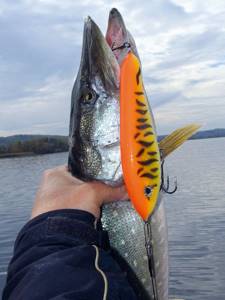
The most important thing when fishing in channels is to find a school of bleak. As a rule, it is enough to find it at this time once and remember this place - practice shows that these places do not change from year to year. And the bleak shows its presence in circles on the water. Having found a bleak, you can be sure that the “shepherds” are somewhere nearby. The favorites in such places are the large wobblers, which we talked about above. The main thing is to take significant breaks between jerks.
Once we were standing “on the bleak”, there were no bites, and the question of changing the place already arose. But on the next retrieve I got distracted and, while talking with my partner, I only slightly moved the wobbler with the tip of the spinning rod. This is where the bite happened. Having made our conclusions, we begin to periodically catch pike on super-slow retrieves. And all bites occur during long pauses, during which we only slightly move the wobbler.
In addition to fishing in snags, fishing on the edges also showed good results. Just not with deep-sea twitching, as in September, but with large wobblers and classic twitching. We knew several places on the riverbed where pike went to feed during the day. Fishing in such places has always brought good results. We always tried to get here while it was still dark so that we could start fishing at dawn.
It often happened that the pike showed its presence in splashes, this was especially visible in calm weather. In such cases, fishing took place, as they say, “by splash.” It was necessary to throw the wobbler over the place where the pike splashed and start jerking the retrieve - in most cases it all ended in a bite. If there was no bite or it turned out to be empty, then you could try to catch it on the next cast. This option also worked.
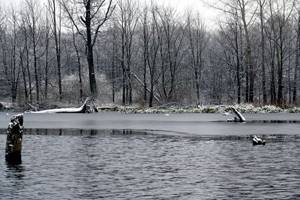
When fishing on the edges, we place the boat at a depth of five-six meters, right on the dump. It is best to cast the bait along the edge or at an acute angle to it (sometimes pike were caught from the shallows), but casting the bait into the depths did not bring results, unless we caught “splash”.
My partner and I often fish “at random”: one, for example, with large wobblers, and the other with a jerk. Until mid-October, the jerk showed slightly better results than the wobbler. But after a week, these two fishing methods showed approximately the same results, and from the twentieth of October it was possible to catch more fish using the classic twitching method than the jerking method.
This, I think, is directly related to the water temperature. In moderately cold water, the predator is very active and more often responds to active bait - jerk. But as soon as the water temperature drops significantly, the fish’s processes slow down, and it is no longer ready to chase an active bait, while at the same time reacting well to a suspender hanging in the water column.
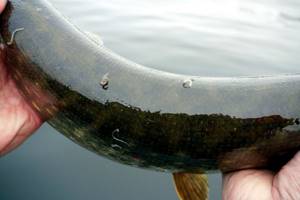
November
This month, the water temperature according to the echo sounder drops to +3 degrees. In the 2009 season, it was at this time that real winter set in several times, the remote bays were covered with ice, but after each cold snap came a thaw. These weather changes did not have the best effect on the predator. His exits became erratic in timing.
We tried several times to fish at dawn at previously proven promising points. If in previous months she was consistently caught on them every morning, now this was not the case. We were unable to tie the pike bite to a specific time, and the outings themselves were more episodic in nature and were very fleeting.
It was possible to tempt the pike to bite with a very slow retrieve with extended pauses. Wobblers with an acoustic effect were used. Here, the same Balisong from DEPS had no competition. All the pike we caught were heavily covered with leeches, which indicated its passivity. And we, as a rule, could not boast of the results.
Sometimes, during a whole day of fishing, we barely managed to catch a pair of tails, and it happened even worse. But things are not always so bad this month. For example, on November 29 last year, the two of us caught 20 tails from 1.5 to 3 kg in two hours of fishing “in snags” (all the fish were released). The bite that day began at about 10 o'clock and lasted until 12, after which everything stopped.
I still can’t say why the pike showed such activity, but its greed knew no bounds.
I only know that exactly a week later, in the places where we were fishing, ice began to rise right before my friend’s eyes. The partner was there in the hope that he would be lucky again, just like the week before. That day, with great difficulty, he was able to catch only a couple of tails. The intensified frost prevented fishing that day, and the water, flowing down the spinning rod, gradually turned it into the staff of Santa Claus. The 2009 spinning season ended on December 6th.
Separately about pike perch
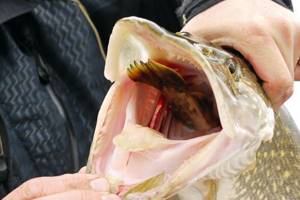
In September, pike perch can be caught well by deep-sea twitching. The main conditions are the presence of a current in the fishing areas and three to six meters of depth. Such places can be local holes (especially under islands) and snags. Starting from about mid-October and until mid-November, pike perch began to be caught more and more often on the channel edges, when we positioned the boat above the very beginning of the drop at a depth of 56 meters. Pike perch acted here as a pleasant by-catch, since the main object of hunting here was pike.
Fishing was carried out with large wobblers and classic twitching. Apparently, the pike perch could not resist the loudly noisy baits. There were fishing trips when the number
The number of pike perch that ended up “in bycatch” even exceeded the number of pike that were purposefully caught. It should be noted that pike perch specimens were caught of a decent size: from 2 to 3.5 kg.
Traditionally, we catch pike perch at this time with a jig, but, as practice shows, the fanged predator sometimes willingly climbs up the slope and takes the bait, which is only two meters deep.

In the 2008 season, constant negative temperatures began only on December 10, and the snow cover began to fall only on December 23. Approximately the same picture emerged in the 2009 season: constant negative temperatures began on December 5, and the snow began to fall on the 18th of this month. True, in the 2010 season, constant sub-zero temperatures began already at the end of November, and on the 23rd there was already snow. Let's see when the winter of 2011 comes and when we have to close the spinning season...
Safety precautions
Since we are talking about fishing in the vastness of a large river in the cold season, safety precautions must be taken with full responsibility. Fishing often takes place in sub-zero temperatures: water flows from the caught fish and from the anchor rope into the boat, which quickly freezes and turns the bottom of the craft into a skating rink. The danger of ending up in icy water is very high. A piece of foam rubber will help remove water without much difficulty.
Often at this time of year there is fog on the reservoir, making it difficult to get home. A navigator will be an indispensable assistant here. Don’t forget about the life jacket, it (like the seat belt in a car) gets in the way at first, then you get used to it and then you simply don’t notice it.
Last but not least, quality clothing. This is especially true in late autumn. It’s great to have equipment that suits the time of year, when neither the wind nor the rain and snow bothers us. And we, without being distracted by trifles, do our favorite thing - FISHING.
Choosing a spinning rod
Having analyzed the criteria for choosing a spinning rod for twitch fishing, we can try to choose among the good fishing rods the most suitable one for you:
PONTOON21 SEVEN&HALF are perfectly balanced blanks made from graphite materials from the Japanese concern Toray. It has Fuji guides of the Tangle Free design (preventing line tangling) with silicon carbide inserts. The price of the rod is 8.5-9 thousand rubles.
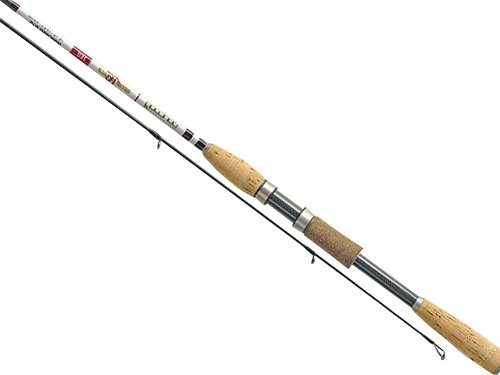
Norstream Kando KDS-662L (Norway) – a spinning rod with a fairly rigid action. Recommended for fishing with short casts on small rivers for fish species such as chub, ide, pike. The cost of the rod is 15-17 thousand rubles.

Restaffine Monster Edition 83H (Japan) is a well-deserved leader among twitching rods. Works great both when twitching and when jigging. Effective when fishing from a boat or elevated shore. Ideal also for long casts. Allows for reliable hooking and landing. The price of the rod is 15-20 thousand rubles.

St.Croix Legend Elite LES70MF2 (USA) is a fishing rod that is one of the top sellers among twitchers. It has a fast action and an ergonomic handle. The length of the rod is 2.10 m, and the test is 5-17 g. The cost of the rod is 23-25 thousand rubles. If rods from well-known brands of fishing tackle are a little expensive for you, then you can choose a decent option among more versatile and budget spinning rods.
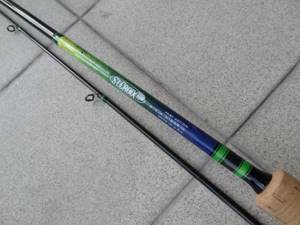
The ADAMS MICROFLEX ULTRA LIGHT spinning rod is a universal fast-action spinning rod that is light in weight. Lightweight and comfortable, with a comfortable two-section handle. If necessary, one section can be removed. Has a super sensitive whip. The cost of the rod is 1.2-1.7 thousand rubles.
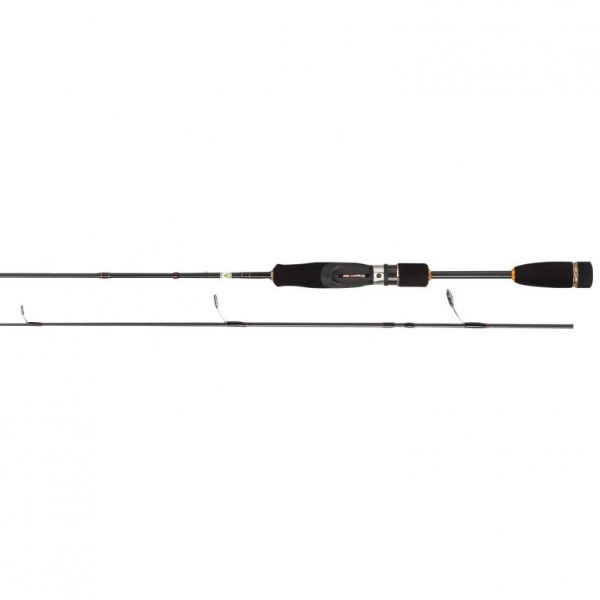
The SabaneevMasterSpin 210 and SalmoEliteX-TwitchMH rods allow you to perform any type of fishing and have a good range. They work optimally when twitching for medium-sized pike and perch.
Twitching baits
There are several criteria for selecting bait for twitching fishing:
Wobbler size
This criterion depends on the object being fished. For perches and small pikes, a wobbler with a length of 3 to 7 cm is suitable; for a large pike it is better to take a seven- or ten-centimeter wobbler.
Color
It is easy to explain the choice of one or another wobbler in specific situations. If we are fishing in a reservoir with muddy or dark water, then it is better to use bait with a bright color. If we are retrieving with pauses, then it is better to take a wobbler with a color close to natural; in pause situations, the predator has the opportunity to examine the bait and it should not cause him doubts.
Buoyancy
One of the characteristics of twitching fishing is determining the size of pauses between jerks.
And in this, the wobbler model is decisive:
- For a floating model, a pause should be made from the jerk until the wobbler rises to the surface and stops completely.
- For suspending, a pause takes the period of time between the jerk and the bait stopping in the water column.
- The sinking wobbler is carried out without pauses at all, otherwise during the pause it begins to sink and this alerts the predator.
The most effective twitching for fishing is suspending (hanging in the water column). This is explained by the fact that during a pause the wobbler stops, while floating or sinking models behave as reflected in their name - they sink or float, which the toothy robbers do not like.
Depth value
This criterion depends on the time of year or fishing conditions. If you take into account the conditions, then when fishing in ponds overgrown with algae or snags, it is better to take a “minnow” with a small blade, in other situations - with a large one. In the summer, when the fish rises higher to the surface, it is better to use floating wobblers, and in the fall the fish sink to the bottom and a sinking bait will work more effectively.
Ability to "play"
Some of the wobblers can only be made playable by the skill of the fisherman. Experienced spinners can pull even a non-playing “minnow” in such a way that no predator can resist the temptation to attack such a “beauty”. And for fishermen who are just learning the wisdom of twitching, it is better to use “playing” wobblers right away.
Chiki is a very active bait that works well in large shallow water areas, where it perfectly provokes an active predator. At the same time, the natural color of such bait does not arouse suspicion among the predator and it attacks furiously. The number of gatherings is minimal.
Twitching and wobblers
It is generally accepted that it is better to use minnows for twitching.
In general, this is true, but there are conditions when the minnow does not cope with the task, but the crank works perfectly.
Minnow
These are elongated wobblers. There are a huge number of models.
Some have their own game (game with even wiring), and some need to be twitched. I'm not even talking about the color scheme, size, presence or absence of noisy elements, etc. One thing is important here - to understand how this particular model should play and choose the wiring for it. And also determine the duration of the pause.
When fishing, when pike are active, I usually use floating wobblers.
You can do more dynamic twitching for them. Which in turn increases the fishing pace and collects active fish faster.
Then suspenders (wobblers with neutral buoyancy) are put into operation. These baits twitch very slowly (although it is possible more dynamically).
The main advantage of suspenders over floating models is the ability to hover in the water column during a pause. Even a passive pike will not be able to miss such a moment and will definitely attack your bait.
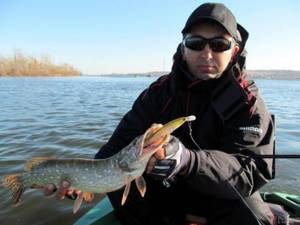
Sinking models
There is another type of wobblers - sinking models. They can sink in water quickly (like a stone) and slowly.
These baits are needed for bottom and near-bottom twitching. Similar minnows are placed on the bottom, raising the turbidity. Or they are carried out in the water column or at the bottom with more dynamic twitching.
Slow sinking can be done almost at the surface. But the most valuable parameter of such wobblers is their mass. They are heavier than other types of minnows. Thanks to this, they can be thrown significantly further. This means reaching fish, which are often too far from the shore (shore twitching).
Cranky
Many people believe that such wobblers can only be fished with uniform wiring or trolling.
But under certain conditions, crank will be a priority when twitching. Well, for example, there is a drop from 3 to 7 m.
To fish such a point with a crank, we set the boat to a depth (in this case 7 m), and cast to the shallows (3 m).
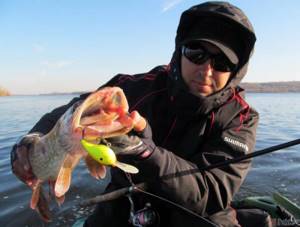
We select a crank with a working depth of up to 7 m. Using a sharp pull, we drive the bait to the depth, and after touching the bottom, we begin to twitch.
At the same time, the wobbler dives deep with a jerk and hits the bottom with its blade, raising the turbidity.
During a short pause, the crank floats up, and on the next jerk it hits the bottom with the blade again. Thus, schematically the movement of the wobbler looks like a herringbone.
Impacts on the bottom and raised turbidity attract fish. The wiring continues until the end of the stall. In this case, the wobbler passes exactly along the slope of the underwater slide.
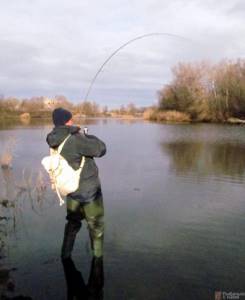
Twitching fishing technique
The twitching fishing technique consists of the fisherman making different jerks: fast and slow, short and long, with pauses between jerks from several seconds to half a minute. Only skillful actions of the fisherman can provoke a predator to attack.
After making the next jerk and returning the rod to its original position, it is important to release the tension on the line with the reel. Rewinding will help protect the reel mechanism from wear or serious damage.
There are several ways of twitching:
- Monotonous - alternating jerks with pauses.
- Rhythmic - cycles of repeating systems of pauses and jerks.
- Chaotic - the play of the wobbler is regulated by the capabilities and desires of the fisherman.
In this case, the question is logical: when do you need to pull the spinning rod often and strongly, and when rarely and weakly? How often should you pause and for how long?
An experienced fisherman will answer that it all depends on factors such as:
- Season.
- Fishing place.
- Weather.
- Fish activity.
If you need to formulate the main rule of twitching fishing, it will look like this: the more active the fish, the faster the retrieve.
The most effective twitching is in situations where a fisherman is fishing from a boat or a hill on the shore, with the spinning rod pointing down. When twitching fishing, you need to experiment with wiring all the time: cast a couple of times and make the retrieve in short jerks with pauses per second, next time try to do it without pauses at all, etc.
Fishing in a pond overgrown with algae. When casting, the tip of the spinning rod rises quite high. Jerks prevent the bait from going deep and prevent snagging. At the same time, the wobbler performs a dance that is quite attractive to the pike, provoking it to attack.
Features of fishing in spring. In early spring, pike searches for shallow water, where the sun warms up the water faster, it prepares for spawning and rests after spawning. You need to choose an elongated wobbler with a shallow blade (minnow), which goes shallow, 20-30 cm with a length of 7-10 cm. The closer to summer, the more “deep-water” the bait should be. It is better if the wobblers are suspended or weakly floating. One of the options is the Team Daiwa Minnow 1091 SP suspender, 9.5 cm long, diving to its maximum depth of 40-50 cm. It is not too demanding on wiring and the predator almost always takes it. The main wiring technique is uniform, not very aggressive jerks followed by reeling in the line.
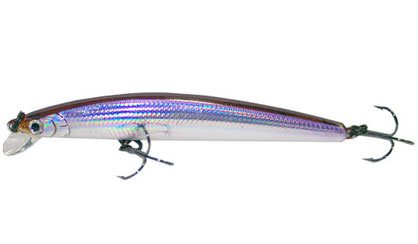
Features of fishing in summer. Rigge Deep 56F, Smith Jade MD 43F perform well , which prevents them from getting caught on water grass and water lilies. To avoid getting the wobbler entangled in the grass, it is better to use floating or shallow-water minnows. It will be effective to alternate small twitches with a smooth winding of the fishing line.
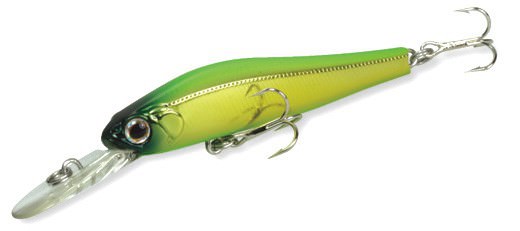
How to fish in the fall. The height of twitching fishing. At this time, predators attack both spring wobblers and deeper ones, with a depth of 2-2.5 m. Rapala X-Rap 10 cm and Rapala Husky Jerk are good for these purposes. As for fishing technology, in the fall we need more aggressive twitching with sharp jerks and a wide amplitude. A longer stretch is needed in combination with pauses. Usually during pauses the fish takes a bite.
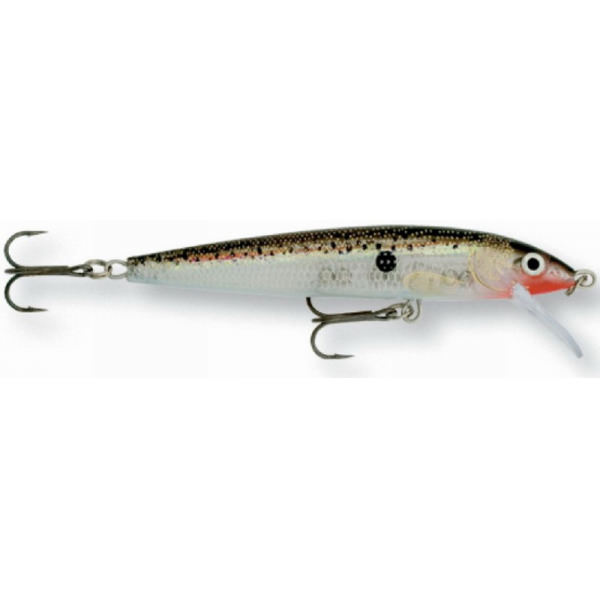
Basic postings in twitching
Jerks and pauses
Jerks in combination with pauses imply, first of all, an increase in the intervals between jerks. In some cases they can reach tens of seconds. You can pause not after each jerk, but after a series of 3-5 jerks, one long one of 5-10 seconds. Very often this technique provokes the fish to bite precisely during the pause.
Stop and go
Stop-and-go wiring is used not only in twitching wobblers, but also in fishing with other lures. But considering that it itself is uneven, we can safely classify it as twitching. In this wiring, uniform wiring alternates with pauses. During pauses, suspenders freeze in the water column, and floating wobblers float up. This is probably one of the simplest postings in twitching.
Soft stretches
In this case, the rod makes a smooth “run” of the wobbler, then, with the tip of the rod moving towards the bait, the extra cord is selected. After this, the next stretch is done with or without a pause. Pulls can also be done by shifting the rod from one side to the other, so the wobbler changes the main direction of movement over a wider range.
Aggressive twitching
Fast, aggressive twitching involves almost continuous reeling with jerks almost without pauses or with pauses of a split second. In this case, the wobbler moves almost continuously, yawing in different directions with an amplitude depending on its structure, the presence and size of the blade. Such wiring has a good effect on an active predator, forcing it to bite, and allows you to quickly fish large areas of water.
More details about the twitching technique and wiring can be seen in the video:
Features of twitching fishing for different types of fish
Perch fishing
With this type of fishing, slow retrieval should be combined with sharp jerks of the rod. If you observe the wobbler, we will note that it slowly moves forward with sharp turns to the left and right. The spinning rod moves continuously, jerking from top to bottom. If the perch does not have a zhor, then the fishing technique is somewhat different: you need to pause between jerks and it is at this time that the perch takes a bite.
You can fish well if you tweet in continuous jerks without pauses, either from top to bottom or from side to side.
Pike fishing by twitching
It is better to choose a place for pike fishing at the sources of rivers or in swampy lakes. A weak current, a grassy river bank or sun-warmed shallows of lakes are the favorite stopping places for predators. Wiring of the wobbler should begin at the edge of the water, a pond overgrown with grass. After casting the wobbler, do not rush to start retrieving, the pike is curious and will be interested in the splash of water. After waiting 5-7 seconds, slowly start playing with the wobbler. In the first seconds you can get a bite.
The technique of fishing for pike differs from fishing for perch in longer jerks with a small amplitude. If the pike is active, then the jerks should not be interrupted by pauses; otherwise, we alternate long jerks with short stops of a few seconds. In hot weather or when pike activity is low, pauses between jerks can be increased to 10 seconds. The more active the fish, the shorter the pauses should be.
Twitching in depth
Autumn is increasingly coming into its own - daylight hours are inexorably shortening, day and night air temperatures are dropping significantly, causing a rapid cooling of the water, entailing the death of all kinds of aquatic vegetation. Reservoirs are gradually freed from the captivity of algae growing both in the water column and on the surface, so that spinning fishing becomes more comfortable. Particularly pleasing is the death of the tough vines of the Red Book water chestnut-chipima, which recently literally filled all the reservoirs of the Dnieper cascade. Not only that, in many places they are completely overgrown with shallow waters with depths of up to 2 m. so its strong stems stretch to the surface even at a depth of 3-4 m, seriously complicating fishing in these areas.
It is believed that deep places in reservoirs, especially when results are needed at any cost, are most effectively fished with a jig. And not everyone knows that at depths of up to 4-5 m, various wobblers can seriously compete with “silicone”: rattlins, deep-sea minnows and all kinds of cranks and shads in deep form. Just remember that each subclass of wobblers requires different feeding methods. The same rattlins and sinking minnows. As a rule, it is best to catch on a regular stepped retrieve, preferably with elements of twitching, and models that have play in the falling phase are especially effective. For example, sinking minnows. which, when falling, sway their sides and tremble slightly, or rattlins, lying on their side on a loose cord and gliding down in a wide spiral. If we talk about minnows, then models with a depth of 2 to 3 m usually have a more or less active game of their own. With such wobblers it is quite possible to catch a simple “uniform”, but in recent years, with the craze for jerking, our spinning brother, in the vast majority of cases, successfully catches a variety of predatory fish using deep-sea minnow twitching. And this undoubtedly became a classic of deep-sea twitching. however, as we gained experience and with a natural desire to expand our fishing arsenal, many of us began to try to twitch baits that seemed not originally designed for jerking. We started trying to fish by twitching with so-called idiot baits - all kinds of cranks with shad and their various transitional forms, which have an active game of their own and do not require any additional effort to revive them (just cast and pull, the lure will do the rest itself). At first, things didn’t go very well: it was not clear how you could twitch baits with an active game of your own, forcing them to unfold on the spot... while not allowing this very game to turn on. Many models were tested, and the strength and sharpness of the twitches necessary for their technically correct wiring were selected experimentally. Over time, it became clear that some models are completely unsuitable (or unsuitable) for jerking (for example, cranks with a very long and large blade), while others are perfectly suited for this purpose. Certain patterns were also identified. Well. for example: when twitching deep cranks and shads, a rule applies that is common to all deep-sea lures, including minnows - the smaller and narrower the wobbler blade is, the stronger and sharper the wrist jerk we can perform. And, conversely, the wider and larger the area of the bait blade, the more gentle the twitches should be, otherwise unwanted “turning on” of your own game is inevitable. Despite all the apparent external monotony, classic cranks have different characteristics. Some of them are “aggressive”, more suitable for “evenness” (although there are, as we will see below, pleasant exceptions). others are much less active, ideal for jerking. The “aggressive” ones have a wide blade that strongly shakes the body of the bait, which produces powerful vibrations; in addition, they have a wide body that strongly pushes the water in front of it, and a loud noise chamber. “Inactive” ones have a narrow blade that gives play with weak vibrations, their body is narrow, sliding more freely through the water, the noise chamber is small or absent altogether. What matters to us, first of all, is the area and geometry of the bait blade, since the force that must be applied to deploy the wobbler depends on this. As a rule, the larger the area of the wobbler blade, the lighter and shorter, one might say delicate, the wrist jerk performed should be. But this is in general terms, and in each specific case an individual approach is needed, because we all fish with different rods that differ in length, action, and power. So, for example, in order to pull the same bait with a soft and long rod, you need to perform a strong jerk, and with a short and hard one, you only need to slightly move the wobbler with a short movement. If many minnow wobblers on a jerk retrieve move to the sides in different ways (some models move very widely, while others scour in a narrower corridor), then cranks and shads behave almost identically in this situation. The only difference is that most shad scour left and right in a fairly monotonous manner, while cranks, especially those with a downward-curved tail, are somewhat chaotic. But all of them, regardless of the model, with technically correct wiring, scour the sides very realistically, turning 90° relative to the direction of wiring. Moreover, all this happens practically in one place, so the speed of the bait moving forward, in comparison with the same minnows, is extremely low. It is this “slowness” that makes them bait No. 1, which often acts as the “last argument” when catching inactive fish that do not want to chase fast-moving baits and do not react, it would seem, to anything. The vast majority of cranks and shads are produced floating (neutral buoyancy models are very few). Naturally, wobblers with very high buoyancy, which quickly float up during a pause in the retrieve, and baits that float up slowly, have different areas of application, and their technique is equally different. Deep sea shad, as well as deep cranks. even during a uniform drive they create very strong vibrations, and with jerks the strength of these impulses increases many times over, which attracts a predator from a great distance. After all, as you know, every fish, when moving in water, leaves behind a vortex trail, to which, using the lateral line, the predator first of all focuses in search of prey (and only at a close distance does vision “turn on”). Consequently, the wobbler that leaves behind itself the most powerful vortex trail will, all other things being equal, be the most noticeable to predatory fish.
Blitz tips
- The twitching fishing technique allows you to fish in any body of water, but it will be most effective in quiet backwaters and coastal areas of lakes.
- The worst enemy of twitching is the wind. It interferes with casting and control of the retrieve.
- The success of fishing by twitching is proportional to the fisherman’s ability to move the wobbler in such a way that it resembles an appetizing fish as much as possible.
- If the length of the spinning rod is up to 210 mm, then the handle of the form should be short.
- The rod leash is used rigid; it is better to use steel wire with a twist at the end, rather than with a fastener.
